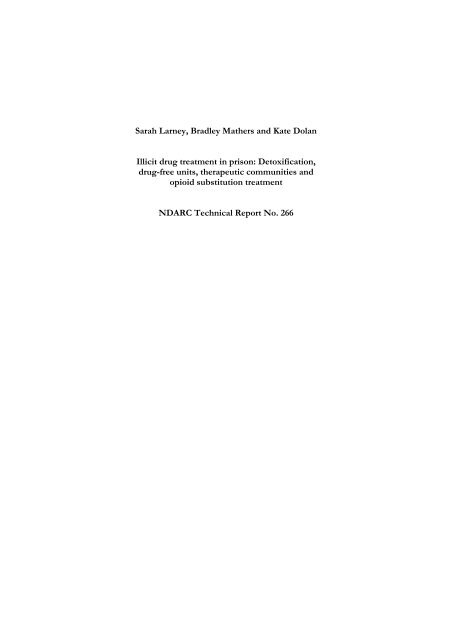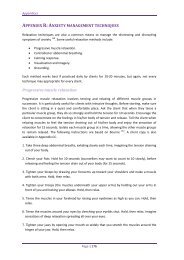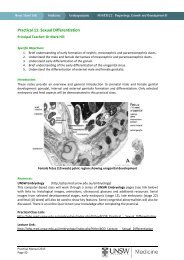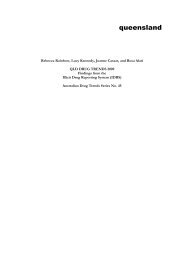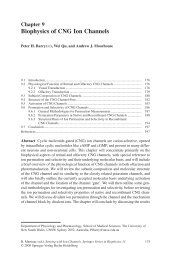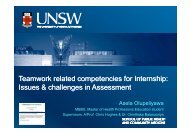Sarah Larney, Bradley Mathers and Kate Dolan Illicit drug treatment ...
Sarah Larney, Bradley Mathers and Kate Dolan Illicit drug treatment ...
Sarah Larney, Bradley Mathers and Kate Dolan Illicit drug treatment ...
- No tags were found...
Create successful ePaper yourself
Turn your PDF publications into a flip-book with our unique Google optimized e-Paper software.
<strong>Sarah</strong> <strong>Larney</strong>, <strong>Bradley</strong> <strong>Mathers</strong> <strong>and</strong> <strong>Kate</strong> <strong>Dolan</strong><strong>Illicit</strong> <strong>drug</strong> <strong>treatment</strong> in prison: Detoxification,<strong>drug</strong>-free units, therapeutic communities <strong>and</strong>opioid substitution <strong>treatment</strong>NDARC Technical Report No. 266
ILLICIT DRUG TREATMENTIN PRISON:DETOXIFICATION, DRUG-FREE UNITS,THERAPEUTIC COMMUNITIES AND OPIOIDSUBSTITUTION TREATMENT<strong>Sarah</strong> <strong>Larney</strong>, <strong>Bradley</strong> <strong>Mathers</strong> <strong>and</strong> <strong>Kate</strong> <strong>Dolan</strong>Technical Report No. 266ISBN: 978 0 7334 2429 8© NATIONAL DRUG AND ALCOHOL RESEARCH CENTRE,UNIVERSITY OF NEW SOUTH WALES, SYDNEY, 2007This work is copyright. You may download, display, print <strong>and</strong> reproduce this material in unaltered formonly (retaining this notice) for your personal, non-commercial use or use within your organisation.All other rights are reserved. Requests <strong>and</strong> enquiries concerning reproduction <strong>and</strong> rights should beaddressed to the Information Manager, National Drug <strong>and</strong> Alcohol Research Centre, University of NewSouth Wales, Sydney, NSW 2052, Australia.2
AcknowledgementsAn earlier draft of this report was prepared for the National Treatment Agency, UnitedKingdom, for use in the development of guidelines for <strong>drug</strong> <strong>treatment</strong> in prisons.Benjamin Phillips <strong>and</strong> Effat Merghati Khoei contributed to an earlier draft of this report.4
CONTENTSAcknowledgements.................................................................................................. 41. INTRODUCTION ............................................................................................ 82. DETOXIFICATION.........................................................................................102.1 Opiate detoxification...................................................................................102.1.1 Alpha2-adrenergic agonists .......................................................................................... 102.1.2 Opioid agonists.............................................................................................................. 112.1.3 Symptomatic <strong>treatment</strong>................................................................................................. 122.2 Psychostimulant detoxification...................................................................122.2.1 Symptomatic <strong>treatment</strong>................................................................................................. 122.2.2 Psychiatric complications ............................................................................................. 132.2.3 Experimental pharmacotherapies................................................................................ 132.3 Psychological support .................................................................................133. DRUG-FREE WINGS.......................................................................................144. THERAPEUTIC COMMUNITIES .....................................................................164.1 Impacts on <strong>drug</strong> use....................................................................................164.2 Impacts on criminal recidivism ..................................................................164.3 Identifying factors associated with <strong>treatment</strong> completion .........................175. OPIOID SUBSTITUTION TREATMENT...........................................................195.1 Opioid substitution <strong>treatment</strong> in community settings ...............................195.2 Opioid substitution <strong>treatment</strong> in prison .....................................................205.2.1 Rationale for opioid substitution <strong>treatment</strong> in prison.............................................. 205.2.2 Methadone maintenance <strong>treatment</strong> ............................................................................ 205.2.3 Buprenorphine maintenance <strong>treatment</strong>...................................................................... 235.2.4 Levo-alpha-acetylmethadol maintenance <strong>treatment</strong>................................................. 246. CONCLUSIONS..............................................................................................257. REFERENCES................................................................................................276
1. INTRODUCTIONThe relationship between <strong>drug</strong>s, crime <strong>and</strong> subsequent imprisonment is acknowledgedaround the world. Estimates of the prevalence of illicit <strong>drug</strong> use <strong>and</strong> dependence amongmale prisoners range from 17-30%; among female prisoners, this rises to 30-60% (Fazel,Bains, & Doll, 2006). In the United Kingdom, 80% of surveyed prisoners reportedhaving ever used any illicit <strong>drug</strong> (Boys et al., 2002). Of sentenced prisoners surveyed,43% of men <strong>and</strong> 41% of women met criteria for dependence on at least one illicit <strong>drug</strong>(Singleton, Farrell, & Meltzer, 1999). In New South Wales (NSW), Australia, inmatehealth surveys have shown that two thirds of male prisoners, <strong>and</strong> three quarters offemale prisoners, had used illicit <strong>drug</strong>s regularly in the twelve months prior toimprisonment (Butler & Milner, 2003). The proportion of prisoners reporting regular useof selected illicit <strong>drug</strong>s is shown in figure 1.1.Figure 1.1: Percent of NSW prisoners reporting regular <strong>drug</strong> use in the 12 monthsprior to imprisonment, by <strong>drug</strong> type.Percent reporting regular use in the 12 months priorto imprisonment605040302010050.232.629.620.6Cannabis Heroin Amphetamine CocaineSource: Butler, T., & Milner, L. (2003). The 2001 New South Wales Inmate Health Survey. Sydney:Corrections Health Service.Although it is recognised that offering <strong>drug</strong> <strong>treatment</strong> to <strong>drug</strong>-using offenders maycontribute to reducing re-offending, <strong>treatment</strong> availability is often limited (Kothari,Marsden, & Strang, 2002). In many countries, resources within prisons are scarce <strong>and</strong>8
devoted to areas such as security. However, prisoners retain the right to adequatehealthcare, including access to effective <strong>treatment</strong>s for <strong>drug</strong> dependence. Furthermore,according to the principle of equivalence of care, prisoners have the right to receivehealthcare equivalent to that available in the community (World Health Organization,1992). The issues of <strong>drug</strong> dependence <strong>and</strong> <strong>treatment</strong> in prison take on added importancein the context of the global HIV epidemic. Prisons are important sites of HIVtransmission due to sharing of <strong>drug</strong> injecting equipment <strong>and</strong> unprotected sexual activity(UNAIDS, 2006). Yet through the provision of effective <strong>drug</strong> <strong>treatment</strong>, prisons can alsobe sites for HIV education <strong>and</strong> prevention.This report summarises the published literature on illicit <strong>drug</strong> detoxification <strong>and</strong><strong>treatment</strong> interventions in prisons. Where relevant, literature on community-basedinterventions is also discussed. This report is not intended to be used as a guide forclinical practice; rather, its aim is to draw attention to various approaches for the<strong>treatment</strong> of illicit <strong>drug</strong> dependence in prison settings.9
2. DETOXIFICATIONDetoxification is the management of withdrawal symptoms associated with the cessationof a <strong>drug</strong> of dependence. While not a <strong>treatment</strong> for <strong>drug</strong> dependence in itself, assisting a<strong>drug</strong> dependent person to detoxify safely <strong>and</strong> with a minimum of discomfort or dangerto their health may lead to further opportunities for clinicians to provide harm reductioninterventions or <strong>drug</strong> <strong>treatment</strong> services.There is a paucity of literature detailing or evaluating detoxification protocols in eithercommunity or prison settings. However, detoxification in prison need not differmarkedly from that provided in the community. Withdrawal can be managed in anumber of ways, depending on the <strong>drug</strong> or <strong>drug</strong>s of dependence. Medical interventionmay assist the detoxification process, particularly in the case of opiate dependence.Alternatively, detoxification can be managed non-medically, through the provision ofpsychological support <strong>and</strong> care.2.1 Opiate detoxificationOpiate detoxification is rarely life-threatening <strong>and</strong> clinical management is uncomplicated.Management of opiate withdrawal typically involves the use of alpha2-adrenergic agonists(e.g. clonidine, lofexidine), opioid agonists (e.g. methadone, buprenorphine) <strong>and</strong>/orsymptomatic <strong>treatment</strong>.2.1.1 Alpha2-adrenergic agonistsOne of the neurological mechanisms underlying opioid withdrawal is noradrenergichyperactivity. Alpha2-adrenergic agonists, such as clonidine <strong>and</strong> lofexidine, relieve opiatewithdrawal symptoms by moderating this activity (Gowing, Farrell, & White, 2004).Several community-based studies have examined the use of clonidine <strong>and</strong> lofexidine. Areview of studies found that withdrawal symptoms are similar whether adrenergicagonists or methadone is utilised. Treatment retention is worse compared to methadone-10
assisted detoxification <strong>and</strong> clonidine, in particular, is associated with adverse side-effectssuch as dizziness <strong>and</strong> hypotension (Gowing, Farrell, & White, 2004).Adrenergic agonists are attractive for use in prison settings due to their low potential fordependence <strong>and</strong> diversion. One r<strong>and</strong>omised controlled trial comparing lofexidine tomethadone in prison has been conducted. Opiate dependent inmates were r<strong>and</strong>omisedon reception to receive either lofexidine or methadone over ten days. There were noclinically significant differences between groups in severity of withdrawal symptoms.Treatment retention was higher in the methadone group (88% v. 70%), but thisdifference was not statistically significant. The authors concluded that lofexidine iscomparable to methadone in effectiveness in managing withdrawal <strong>and</strong> is a viablealternative for opiate detoxification (Howells et al., 2002).One concern related to the use of alpha-2 adrenergic agonists is their potentialhypotensive effects. Lofexidine has been found less likely than clonidine to cause sucheffects (Gowing, Farrell, & White, 2004). In the prison-based study of lofexidine, nohypotensive episodes related to administration of this medication were identified(Howells et al., 2002).2.1.2 Opioid agonistsOpioid agonists relieve opioid withdrawal symptoms by mimicking the effects of illicitopiates such as heroin. Methadone <strong>and</strong> buprenorphine are the agonists most frequentlyused in detoxification. They are provided in reducing doses over the course of thewithdrawal syndrome, typically for 7-10 days.Buprenorphine is generally considered a superior detoxification agent to methadone as itis quicker to alleviate withdrawal symptoms (Gowing, Ali, & White, 2006).Buprenorphine is also superior to alpha2-adrenergic agonists in ameliorating withdrawalsymptoms (Mattick et al., 2001). However, the administration of buprenorphine in prisonsettings can be problematic; tablets must be absorbed sub-lingually, which may takeseveral minutes per patient, <strong>and</strong> this process must be supervised to minimise diversion.11
To date, there have been no published studies examining the use of buprenorphine forwithdrawal management in prison <strong>and</strong> only two studies of methadone. One, a descriptivestudy of 49 newly received inmates, noted that while withdrawal severity was reducedthrough the use of methadone, symptom relief was not complete (Jeanmonod, Harding,& Staub, 1991). The other was the r<strong>and</strong>omised controlled trial comparing methadone tolofexidine, as described above in section 2.1.1. To reiterate, methadone treated patientswere more likely than lofexidine treated patients to be retained in <strong>treatment</strong>, but thisdifference was not statistically significant (Howells et al., 2002).2.1.3 Symptomatic <strong>treatment</strong>Withdrawal symptoms such as nausea, vomiting, cramps <strong>and</strong> diarrhoea can be treatedsymptomatically as they arise. Symptomatic <strong>treatment</strong> can be provided in conjunctionwith the pharmacotherapies described above.The only study on the use of symptomatic <strong>treatment</strong> for opioid withdrawal wasconducted in a community setting <strong>and</strong> referred to the use of ‘clonidine plus symptomaticmedications’. This combination was found to be inferior to buprenorphine-assistedwithdrawal in terms of <strong>treatment</strong> completion <strong>and</strong> entry into post-withdrawal <strong>treatment</strong>(Mattick et al., 2001).2.2 Psychostimulant detoxificationPsychostimulants include cocaine <strong>and</strong> methamphetamine. Treatment for withdrawaltypically consists of psychological support (see section 2.6 below), symptomatic<strong>treatment</strong> <strong>and</strong> observation for psychiatric complications.2.2.1 Symptomatic <strong>treatment</strong>Withdrawal symptoms such as cramps, anxiety <strong>and</strong> insomnia can be treatedsymptomatically as they arise.12
2.2.2 Psychiatric complicationsOngoing psychostimulant use can result in mood disturbances <strong>and</strong>/or psychosis. Patientsmust be carefully assessed for psychosis, depression <strong>and</strong> suicidal ideation <strong>and</strong> appropriatemedications prescribed. Patients with severe psychosis or suicidal ideation may requirehospitalisation.2.2.3 Experimental pharmacotherapiesStudies are underway to determine the efficacy of mirtazapine in treatingpsychostimulant withdrawal. A recent study in a criminal justice setting in Thail<strong>and</strong>found that patients treated with mirtazapine had reduced withdrawal severity scorescompared to a placebo group (Kongsakon, Papadopoulos, & Saguansiritharn, 2005).Pending further studies, mirtazapine may be a useful pharmacotherapy for use inpsychostimulant detoxification in prisons.2.3 Psychological supportPsychological support in the form of accurate information regarding withdrawalsymptoms <strong>and</strong> strategies for coping with cravings can be useful in reducing patientanxiety <strong>and</strong> preparing the patient for the withdrawal experience. Psychological support isalso valuable in cases where withdrawal symptoms continue beyond the provision ofwithdrawal medications. Providing psychological support during withdrawal adds to theeffectiveness of pharmacological <strong>treatment</strong>s (Amato et al., 2004).13
3. DRUG-FREE WINGSVoluntary <strong>drug</strong>-free units or <strong>drug</strong>-free wings are a form of residential correctional<strong>treatment</strong> program with the primary objective of rehabilitating offenders with histories ofillicit <strong>drug</strong> use. Inmates residing in <strong>drug</strong>-free wings are segregated from the generalprison population <strong>and</strong> pledge to abstain from <strong>drug</strong> use, usually in return for increasedprivileges such as recreational facilities or improved accommodation. Inmates areregularly urine tested <strong>and</strong> punishments for a positive urinalysis include loss of privilegesor expulsion from the program (Incorvaia & Kirby, 1997). Drug-free units are usedwidely across Europe (Zurhold, 2004) <strong>and</strong> Australia (Black, <strong>Dolan</strong>, & Wodak, 2004), yetvery little is known about their long-term effectiveness as few have been evaluated.Programs offered in <strong>drug</strong>-free wings also vary widely so the precise factors thatcontribute to a positive rehabilitative environment are uncertain.A study of a <strong>drug</strong>-free wing in a Dutch prison compared behavioural changes of inmatesin a <strong>drug</strong>-free wing to those in the general prison population <strong>and</strong> those in a specialist<strong>drug</strong>-free detention centre. Schippers et al (1998) concluded that there were nodifferences between these groups at one-year follow-up on <strong>drug</strong> use, criminal recidivism,social functioning or physical functioning. However, compared to the comparison group,a greater proportion of inmates in the <strong>drug</strong>-free wing were referred to <strong>drug</strong> <strong>treatment</strong>after release (64% v. 26%). Inmates from the <strong>drug</strong>-free unit were also more likely thanthose in the comparison group to have actual contact with a <strong>treatment</strong> agency (42% v.8%). These results suggest that <strong>drug</strong>-free wings may assist inmates to access <strong>treatment</strong> onrelease (Schippers, Van den Hurk, Breteler, & Meerkerk, 1998).An analysis of predictors of behaviour change in this study concluded that changes inrecidivism among <strong>drug</strong>-free wing participants could not be predicted. Changes in <strong>drug</strong>use could be predicted to a limited extent by legal status of income; those who reportedthat their main source of income was legal showed a decrease in <strong>drug</strong> use at follow-up(Breteler, Van den Hurk, Schippers, & Meerkerk, 1996).14
More positive findings were reported in an Australian study of a <strong>drug</strong>-free wing. Thirtyoneinmates residing in a <strong>drug</strong>-free wing were compared to 31 inmates in generalpopulation. The majority (84%) of general population inmates surveyed reportedcurrently using <strong>drug</strong>s, compared to one third (32%) of those in the <strong>drug</strong>-free wing.Urinalysis results confirmed a significant difference in <strong>drug</strong> use between the two groups,with half (49%) of general population inmates tested returning positive samples,compared to 6% of those in the <strong>drug</strong>-free wing (Incorvaia & Kirby, 1997). Inmates in the<strong>drug</strong>-free wing also expressed more positive attitudes towards being <strong>drug</strong>-free in prison<strong>and</strong> reducing <strong>drug</strong> use in prison compared to the general population group.Drug-free wings may assist inmates to reduce their <strong>drug</strong> use while in prison <strong>and</strong> to access<strong>drug</strong> <strong>treatment</strong> on release from prison. However, their effectiveness is by no meansestablished. Further research, clarifying the elements of programs conducted in <strong>drug</strong>-freewings <strong>and</strong> their long-term impacts on <strong>drug</strong> use <strong>and</strong> criminal recidivism, is required.15
4. THERAPEUTIC COMMUNITIESThe therapeutic community (TC) is a <strong>drug</strong>-free approach to <strong>treatment</strong> in which <strong>drug</strong> oralcohol dependent individuals live in small, highly structured communities (WHO-WPRO, 2006). TCs in the broader community have been shown to be an effective<strong>treatment</strong> option for a subset of clients (see Gowing, Cooke, Biven, & Watts, 2002, for areview of the TC literature).TCs are commonly found in prisons in the United States, from where much of theresearch literature originates. There is a great deal of theoretical <strong>and</strong> non-empiricalliterature on TCs. This review will only consider empirical TC research that employed acomparison group of non-treated <strong>drug</strong> dependent inmates to assess the impact of TC<strong>treatment</strong> on outcomes such as <strong>drug</strong> use <strong>and</strong> criminal recidivism.4.1 Impacts on <strong>drug</strong> useOnly one study that compared <strong>treatment</strong> <strong>and</strong> non-<strong>treatment</strong> groups on <strong>drug</strong> use wasidentified for this review. A study of TC-treated inmates compared with non-treatedinmates found that participation in <strong>treatment</strong> was the strongest predictor of abstinencefrom illicit <strong>drug</strong> use at five-year follow-up. Participants were more than three times morelikely to be <strong>drug</strong>-free than non-participants (Inciardi, Martin, & Butzin, 2004).4.2 Impacts on criminal recidivismMore research has considered the effect of TC <strong>treatment</strong> on criminal recidivismfollowing release from prison. An evaluation of a TC for incarcerated women found thatwhile 30% of women in a non-treated control group were convicted of another offencefollowing release, only 13% of those who completed the <strong>treatment</strong> program werereconvicted. Of those with any exposure to <strong>treatment</strong>, 22% were reconvicted (Mosher &Phillips, 2006).The impact of TC <strong>treatment</strong> on criminal recidivism is maximised when treated inmatestransfer directly to community-based <strong>treatment</strong> on release from prison. For example, attwo-year follow-up, 36% of a group of inmates who underwent prison-based TC16
<strong>treatment</strong> had been re-arrested, compared to 42% of a matched, non-treated group.However, of inmates who attended both in-prison <strong>treatment</strong> <strong>and</strong> a post-release,community-based TC, only 30% were re-arrested. Compared to the non-treated group,the risk of re-arrest was halved for those who completed both <strong>treatment</strong> programs(Hiller, Knight, & Simpson, 1999).Similarly, the greatest number of days to re-incarceration in a study of TC participants inCalifornia was seen among those who completed both the prison TC program <strong>and</strong> anaftercare program (Wexler, De, Thomas, Kressel, & Peters, 1999). A clear relationshipexisted between <strong>treatment</strong> exposure <strong>and</strong> length of time to re-incarceration, as seen belowin figure 4.1.Figure 4.1: Days to re-incarceration by <strong>treatment</strong> exposure300Days to re-incarceration250200150100500No <strong>treatment</strong> Prison TCdropoutsPrison TCcom pletersAftercaredropoutsAftercarecom pletersSource: Wexler, H. K., et al. (1999). The Amity prison TC evaluation: Reincarcerationoutcomes. Criminal Justice <strong>and</strong> Behaviour, 26(2), 147-167.4.3 Identifying factors associated with <strong>treatment</strong> completionFrom the limited research, it appears that post-prison aftercare programs <strong>and</strong> <strong>treatment</strong>completion are important for achieving positive outcomes. Identifying factors thatinfluence <strong>treatment</strong> completion should be a priority for researchers in this area. As astarting point, studies in the United States have found that participant motivation, race<strong>and</strong> age may be implicated. Melnick et al. (2001) found that greater motivation for<strong>treatment</strong> <strong>and</strong> greater participation in <strong>treatment</strong> was associated with increased <strong>treatment</strong>17
completion, which in turn was associated with lowered criminal recidivism. They suggestthat programs to enhance inmate motivation for <strong>treatment</strong>, conducted in the early stagesof TC <strong>treatment</strong>, may improve <strong>treatment</strong> completion rates (Melnick, De Leon, Thomas,Kressel, & Wexler, 2001). In their study of factors influencing program completion in aTC in a women’s prison, older women were more likely to complete the program thanyounger women, <strong>and</strong> “white” women were more likely to complete <strong>treatment</strong> than “nonwhite”(incorporating African-American, Native American, Hispanic <strong>and</strong> Asian) women(Mosher & Phillips, 2006). This suggests the need to explore the applicability of programcontent to populations from diverse cultural backgrounds.18
5. OPIOID SUBSTITUTION TREATMENTOpioid substitution <strong>treatment</strong> is the medium- to long-term provision of opioid agoniststo heroin- or other opioid-dependent people for the purposes of suppressing opioidcravings <strong>and</strong> improving the health <strong>and</strong> social well-being of the patient (Cropsey,Villalobos, & St. Clair, 2005; Ward, Mattick, & Hall, 1998). Methadone is the mostcommonly used opioid for maintenance purposes, but buprenorphine is also increasinglybeing prescribed (Hall, Ward, & Mattick, 1998).5.1 Opioid substitution <strong>treatment</strong> in community settingsThere is a very strong research base for community-based opioid substitution therapygenerally, <strong>and</strong> methadone maintenance <strong>treatment</strong> (MMT) in particular. MMT has amoderate but significant effect on reducing heroin use (r = .35) (Marsch, 1998) <strong>and</strong> isalso associated with reductions in injecting <strong>drug</strong> use <strong>and</strong> reduced frequency of injecting(<strong>Dolan</strong>, Hall, & Wodak, 1996), benefits that produce reductions in HIV <strong>and</strong> hepatitis Ctransmission. In a recent review of the literature, the HIV seroconversion rate of MMTpatients was lower than that among non-treated injecting <strong>drug</strong> users (Gowing, Farrell,Bornemann, & Ali, 2004).The positive effects of MMT on criminality of heroin users are also well established. Arecent Australian study quantified the effect of MMT on crime rates <strong>and</strong> concluded thatfor every 100 heroin users receiving MMT in the state of New South Wales, there were12 fewer robberies, 57 fewer break-<strong>and</strong>-enters <strong>and</strong> 56 fewer car thefts per year (Lind,Chen, Weatherburn, & Mattick, 2005). Other benefits of MMT include reduced mortalityamong heroin users (Brugal et al., 2005; Langendam, van Brussel, Coutinho, & vanAmeijden, 2001) <strong>and</strong> the relative cost-effectiveness of the <strong>treatment</strong> program in the longterm(Barnett & Hui, 2000; Masson et al., 2004).There is less evidence regarding the effectiveness of buprenorphine <strong>and</strong> othersubstitution therapies. It appears that retention in buprenorphine maintenance <strong>treatment</strong>(BMT) is similar to that of MMT (Mattick, Kimber, Breen, & Davoli, 2003). BMT is also19
of similar cost-effectiveness to MMT (Harris, Gospodarevskaya, & Ritter, 2005). Whilethere is little research regarding LAAM maintenance <strong>treatment</strong>, some results suggest itmay have some advantages over MMT in terms of <strong>treatment</strong> retention <strong>and</strong> suppressionof heroin use (Clark et al., 2002; Longshore, Annon, Anglin, & Rawson, 2005). However,it has been associated with cardiac arrhythmia in some patients <strong>and</strong> its safety as asubstitution therapy is unknown (Clark et al., 2002).5.2 Opioid substitution <strong>treatment</strong> in prison5.2.1 Rationale for opioid substitution <strong>treatment</strong> in prisonAn individual’s <strong>drug</strong> use is usually much less frequent in prison than in the community(<strong>Dolan</strong>, Wodak, Hall, Gaughwin, & Rae, 1996). For this reason it is sometimes arguedthat substitution <strong>treatment</strong> in prison is unnecessary. However, it is the risks associatedwith <strong>drug</strong> injecting in prison that heightens the need for opioid substitution (<strong>Dolan</strong>, Hall,& Wodak, 1998). Drug injection in prison usually involves sharing needles <strong>and</strong> syringes(<strong>Dolan</strong>, Wodak, Hall, Gaughwin, & Rae, 1996), a behaviour that carries with it the risk ofHIV or hepatitis transmission. Providing substitution <strong>treatment</strong> can reduce inmate <strong>drug</strong>use, thereby reducing the risk of viral transmission (<strong>Dolan</strong> et al., 2005).Another risk specific to prisoners is their increased vulnerability to overdose on releasefrom prison. The majority of heroin dependent prisoners use heroin shortly after theirrelease (<strong>Dolan</strong>, Wodak, Hall, Gaughwin, & Rae, 1996). Prisoners who have had littleexposure to opiates during imprisonment have reduced tolerance, leaving themvulnerable to overdose <strong>and</strong> death (Bird & Hutchinson, 2003; Darke, Ross, Zador, &Sunjic, 2000). Providing substitution <strong>treatment</strong> either throughout the length of thesentence or on a pre-release basis (sometimes referred to as ‘retoxification’) <strong>and</strong> ensuringuninterrupted transition to community-based pharmacotherapy programs can protectagainst this outcome.5.2.2 Methadone maintenance <strong>treatment</strong>The majority of Western European prison systems offer MMT to prisoners in their care(Kerr & Jurgens, 2004). Prison-based MMT is also provided in Australia (<strong>Dolan</strong> et al.,20
2005), Canada (Johnson, van de Ven, & Grant, 2001) <strong>and</strong> limited locations in the UnitedStates (Rich et al., 2005) <strong>and</strong> Indonesia (AIDS Project Management Group, 2005).Findings from studies of prison-based MMT programs reflect what is known aboutMMT in the community. As in the community, imprisoned heroin injectors who receiveMMT inject <strong>drug</strong>s significantly less frequently than those not receiving this <strong>treatment</strong>. Astudy of injecting <strong>drug</strong> users in prison in New South Wales (NSW), Australia found thatMMT patients reported significantly fewer injections per week than non-treated injectors(mean no. injections per week .16 v .35; p=.03) (<strong>Dolan</strong>, Hall, & Wodak, 1996). Ar<strong>and</strong>omised controlled trial of the NSW prison MMT program reported that treatedinmates injected significantly less often than the control group at two, three <strong>and</strong> fourmonthfollow-up periods. Lower <strong>drug</strong> use among the control group was confirmedthrough analysis of hair samples (<strong>Dolan</strong> et al., 2003).A study of a pilot methadone maintenance program in a prison in Peurto Rico also foundthat heroin use was markedly reduced among program participants. Heroin use in prisonin the thirty days prior to beginning <strong>treatment</strong> was compared to heroin use in the firstthirty days of <strong>treatment</strong>. While all patients had used heroin in the thirty days prior to<strong>treatment</strong>, only one of 18 used heroin after starting <strong>treatment</strong> (Heimer et al., 2006).Prison-based MMT has a positive effect on criminal recidivism <strong>and</strong> re-incarceration. Astudy of the Canadian prison MMT program followed patients for two years followingrelease. At twelve-month follow-up, a smaller proportion of the <strong>treatment</strong> group than thecontrol group had been charged with a new offence (17% v. 23%) <strong>and</strong> 41% of the<strong>treatment</strong> group had been re-incarcerated, compared to 58% of the control group. Attwo-year follow up, the control group was 28% more likely to have been re-incarceratedthan the <strong>treatment</strong> group (Johnson, van de Ven, & Grant, 2001). In NSW, risk for reincarcerationdecreased as retention in MMT increased such that risk of re-incarcerationwas reduced by 70% during MMT periods of eight months or longer (<strong>Dolan</strong> et al., 2005).Reductions in recidivism <strong>and</strong> consequent re-incarceration are maximised through theprovision of moderate to high doses of methadone. A study of inmates released from a21
prison in New York revealed that those discharged on a higher dose of methadone(defined as 60mg or greater) were less likely to return to prison than those on low doses.The high-dose group also took longer than the low-dose group to return to prison (M =253 days v. 187 days) (Bellin et al., 1999).The impacts of MMT on mortality among prisoners are still to be fully explored. In afour-year follow-up study of the NSW prison methadone r<strong>and</strong>omised controlled trial,seventeen of 382 participants died during the follow-up period. All deaths occurred whileparticipants were not in MMT. Eight of the deaths were <strong>drug</strong> overdoses. Of these, fourhad never received methadone <strong>treatment</strong> <strong>and</strong> four had ceased methadone <strong>treatment</strong> priorto release from prison (<strong>Dolan</strong> et al., 2005), underscoring the importance of uninterruptedtransfer from prison to community-based <strong>treatment</strong>.MMT is the only prison-based <strong>drug</strong> <strong>treatment</strong> for which cost-effectiveness data areavailable. A recent cost-effectiveness study analysed the cost of MMT per heroin free daycompared to no MMT in the context of the NSW prison methadone program. The totalcost of the program (including administrative costs, clinical delivery costs <strong>and</strong> dispensingcosts) was estimated at AU$4.8 million annually. Assuming that the cost of not providingMMT is zero, the additional cost of the program is AU$3,234 per prisoner per year. Thisis no more expensive than community MMT programs in Australia (Warren et al., 2006).Based on data from <strong>Dolan</strong> et al. (2003), it was estimated that inmates in MMT useheroin 15 days per year, compared to 100 days of heroin use per year for non-treatedinmates. The cost of producing these heroin-free days was AU$38 per person-day, whichcompared favourably with costs associated with heroin-related morbidity <strong>and</strong> mortality(Warren et al., 2006).While there are currently no studies that demonstrate an impact of prison-based MMTon the transmission of HIV, there is evidence for its impact of hepatitis C transmission.The four-year follow-up study of patients in the NSW prison MMT program found thathepatitis C incidence among the treated group (16 cases per 100 person-years) was lowerthan the non-treated group (27 cases per 100 person-years), however this difference wasnot statistically significant (p = .08). Seroconversion was associated with shorter (lessthan five months) periods of MMT <strong>treatment</strong> (<strong>Dolan</strong> et al., 2005). In the same trial, HIV22
incidence was just 0.3 per hundred person years, reflecting the low prevalence (
5.2.4 Levo-alpha-acetylmethadol maintenance <strong>treatment</strong>Levo-alpha-acetylmethadol (LAAM) is similar to methadone in that it suppresses heroinwithdrawal symptoms <strong>and</strong> reduces cravings for opiates. However, while methadoneachieves these effects for 24 hours, LAAM does so for 48-72 hours, removing the needfor daily dosing.LAAM is not widely prescribed in the community <strong>and</strong> no prison jurisdiction in the worldroutinely prescribes LAAM as a <strong>treatment</strong> for opioid dependence. The only study ofLAAM in prison is a r<strong>and</strong>omised controlled trial of a pilot project in one prison inBaltimore, United States. Prisoners with a history of opioid dependence receive LAAMfor three months pre-release (Kinlock, Battjes, Schwartz, & the MTC Project Team,2002, , 2005). Post-release, there was no difference between the <strong>treatment</strong> <strong>and</strong> controlgroups on number of heroin-using days. However, the <strong>treatment</strong> group reportedsignificantly fewer heroin-using days than a group of participants who were assigned to<strong>treatment</strong> but did not receive it for administrative or personal reasons (M = 66 v. 167)(Kinlock, Battjes, Schwartz, & the MTC Project Team, 2005).There were no differences between the three groups (<strong>treatment</strong>, control <strong>and</strong> those whowithdrew before starting <strong>treatment</strong>) on number of days committing crime. However, the<strong>treatment</strong> group reported significantly lower income from crime compared to the othertwo groups (M = $155 v. $640 <strong>and</strong> $470). There were no differences between the<strong>treatment</strong> <strong>and</strong> control groups with regard to arrest or reincarceration at nine-monthfollow-up. However, the <strong>treatment</strong> group was significantly less likely to have beenarrested or reincarcerated compared to the group who withdrew before starting<strong>treatment</strong> (arrested 33% v. 58%; reincarcerated 29% v. 58%) (Kinlock, Battjes, Schwartz,& the MTC Project Team, 2005).High participant attrition specific to the <strong>treatment</strong> group in this study limits the strengthof conclusions that can be drawn regarding the effectiveness of LAAM in prison settings.Pending further research, LAAM may be effective in suppressing heroin use <strong>and</strong>reducing recidivism <strong>and</strong> re-incarceration.24
6. CONCLUSIONSThis report has reviewed four interventions for <strong>drug</strong>-dependent prisoners: detoxification;<strong>drug</strong>-free units; therapeutic communities; <strong>and</strong> opioid substitution <strong>treatment</strong>. None ofthese <strong>treatment</strong> options have been thoroughly studied in the prison context, although theevidence base is increasing in the cases of therapeutic communities <strong>and</strong> opioidsubstitution <strong>treatment</strong>. On current evidence, methadone maintenance <strong>treatment</strong> is themost effective <strong>treatment</strong> for reducing <strong>drug</strong> use <strong>and</strong> criminal recidivism. It may also assistin reducing HIV <strong>and</strong> other blood borne virus transmission. However, this <strong>treatment</strong> issuitable only for opioid-dependent populations; users of psychostimulants <strong>and</strong> othernon-opioid <strong>drug</strong>s remain poorly served by current <strong>treatment</strong> approaches, both in thecommunity <strong>and</strong> in prison.This literature review has identified a number of areas requiring further research:Detoxification:• Buprenorphine is widely considered the most efficacious agent for opioiddetoxification; however, in prison settings, administration of this medication canbe problematic. An exploratory study to develop <strong>and</strong> evaluate innovative<strong>treatment</strong> protocols that minimise problems is warranted.• Clinical trials to evaluate the effectiveness of pharmacological agents forpsychostimulant detoxification are underway. These studies should be exp<strong>and</strong>edto include prison populations.Drug-free units:• There has been very little methodologically rigorous research into <strong>drug</strong>-free units.Specific topics requiring closer examination include defining <strong>drug</strong>-free units <strong>and</strong>how they differ from other non-pharmacological <strong>treatment</strong> options such astherapeutic communities; <strong>and</strong> identification of program elements that contributeto decreased <strong>drug</strong> use.Therapeutic communities:• Surprisingly few studies have focused on reduced <strong>drug</strong> use or improved inmatehealth following therapeutic community <strong>treatment</strong>. Studies focusing on these25
outcomes should be conducted. Other <strong>treatment</strong> outcomes that could also beconsidered include reduced incidence of blood borne viral infections <strong>and</strong>mortality.• Identifying program elements that increase positive outcomes should be apriority for researchers, as should improving outcomes for prisoners fromculturally <strong>and</strong> ethnically diverse backgrounds.Opioid substitution <strong>treatment</strong>:• Further r<strong>and</strong>omised controlled trials of methadone maintenance <strong>treatment</strong>should be conducted. In particular, further evidence should be collected onMMT in prisons in non-Western countries <strong>and</strong> low- <strong>and</strong> middle-incomecountries.• R<strong>and</strong>omised controlled trials of buprenorphine maintenance <strong>treatment</strong> should beconducted to provide evidence of the effectiveness or otherwise of this <strong>treatment</strong>in prison settings.Findings from research projects such as those listed above will help to build the evidencebase for providing effective <strong>drug</strong> <strong>treatment</strong> in prison.26
7. REFERENCESAIDS Project Management Group. (2005). Is there anyone left in the general population? A scanof information available on the context of HIV transmission <strong>and</strong> risk for vulnerable groups inseventeen countries with concentrated HIV epidemics: AIDS Project Management Group.Amato, L., Minozzi, S., Davoli, M., Vecchi, S., Ferri, M., & Mayet, S. (2004). Psychosocial<strong>and</strong> pharmacological <strong>treatment</strong>s versus pharmacological <strong>treatment</strong>s for opioiddetoxification. Cochrane Database of Systematic Reviews(4), Art. No. CD005031.Barnett, P. G., & Hui, S. S. (2000). The cost-effectiveness of methadone maintenance.Mount Sinai Journal of Medicine, 67(5-6), 365-374.Bellin, E., Wesson, J., Tomasino, V., Nolan, J., Glick, A. J., & Oquendo, S. (1999). Highdose methadone reduces criminal recidivism in opiate addicts. Addiction Research,7, 19-29.Bird, S. M., & Hutchinson, S. J. (2003). Male <strong>drug</strong>s-related deaths in the fortnight afterrelease from prison: Scotl<strong>and</strong>, 1996-99. Addiction, 98(2), 185-190.Black, E., <strong>Dolan</strong>, K., & Wodak, A. (2004). Supply, Dem<strong>and</strong> <strong>and</strong> Harm Reduction Strategies inAustralian Prisons: Implementation, Cost <strong>and</strong> Evaluation. Canberra: Australian NationalCouncil on Drugs.Boys, A., Farrell, M., Bebbington, P., Brugha, T., Coid, J., Jenkins, R., et al. (2002). Druguse <strong>and</strong> initiation in prison: results from a national prison survey in Engl<strong>and</strong> <strong>and</strong>Wales. Addiction, 97(12), 1551-1560.Breteler, M. H., Van den Hurk, A. A., Schippers, G. M., & Meerkerk, G. J. (1996).Enrolment in a <strong>drug</strong>-free detention program: The prediction of successfulbehaviour change of <strong>drug</strong>-using inmates. Addictive Behaviors, 21(5), 665-669.Brugal, M. T., Domingo-Salvany, A., Puig, R., Barrio, G., Garcia de Olalla, P., & de laFuente, L. (2005). Evaluating the impact of methadone maintenance programmeson mortality due to overdose <strong>and</strong> AIDS in a cohort of heroin users in Spain.Addiction, 100, 981-989.Butler, T., & Milner, L. (2003). The 2001 New South Wales Inmate Health Survey. Sydney:Corrections Health Service.Clark, N., Lintzeris, N., Gijsbers, A., Whelan, G., Dunlop, A., Ritter, A., et al. (2002).LAAM maintenance vs. methadone maintenance for heroin dependence. TheCochrane Database of Systematic Reviews, 2(Art. No. CD002210).Cropsey, K. L., Villalobos, G. C., & St. Clair, C. L. (2005). Pharmacotherapy <strong>treatment</strong> insubstance-dependent correctional populations: A review. Substance Use & Misuse,40(13-14), 1983-1999.Darke, S., Ross, J., Zador, D., & Sunjic, S. (2000). Heroin-related deaths in New SouthWales, Australia, 1992-1996. Drug <strong>and</strong> Alcohol Dependence, 60(2), 141-150.<strong>Dolan</strong>, K., Hall, W., & Wodak, A. (1996). Methadone maintenance reduces injecting inprison. BMJ, 312, 1162.<strong>Dolan</strong>, K., Hall, W., & Wodak, A. (1998). The provision of methadone within prisonsettings. In J. Ward, R. Mattick & W. Hall (Eds.), Methadone Maintenance Treatment<strong>and</strong> Other Opioid Replacement Therapies. Amsterdam: Harwood Academic Publishers.<strong>Dolan</strong>, K., Shearer, J., MacDonald, M., Mattick, R., Hall, W., & Wodak, A. (2003). Ar<strong>and</strong>omised controlled trial of methadone maintenance <strong>treatment</strong> versus wait listcontrol in an Australian prison system. Drug <strong>and</strong> Alcohol Dependence, 72(1), 59-65.<strong>Dolan</strong>, K., Shearer, J., White, B., Zhou, J., Kaldor, J., & Wodak, A. (2005). Four-yearfollow-up of imprisoned male heroin users <strong>and</strong> methadone <strong>treatment</strong>: Mortality,re-incarceration <strong>and</strong> hepatitis C infection. Addiction, 100, 820-828.27
<strong>Dolan</strong>, K., Wodak, A., Hall, W., Gaughwin, M., & Rae, F. (1996). HIV risk behaviour ofIDUs before, during <strong>and</strong> after imprisonment in New South Wales. AddictionResearch, 4(2), 151-160.Fazel, S., Bains, P., & Doll, H. (2006). Substance abuse <strong>and</strong> dependence in prisoners: Asystematic review. Addiction, 101, 181-191.Gowing, L., Ali, R., & White, J. M. (2006). Buprenorphine for the management of opioidwithdrawal. Cochrane Database of Systematic Reviews(2), Art. No. CD002025.Gowing, L., Cooke, R., Biven, A., & Watts, D. (2002). Towards Better Practice in TherapeuticCommunities. Bangalow: Australasian Therapeutic Communities Association.Gowing, L., Farrell, M., Bornemann, R., & Ali, R. (2004). Substitution <strong>treatment</strong> ofinjecting opioid users for prevention of HIV infection. The Cochrane Database ofSystematic Reviews, 4(Art. No. CD004145).Gowing, L., Farrell, M., & White, J. M. (2004). Alpha2 adrenergic agonists for themanagement of opioid withdrawal Cochrane Database of Systematic Reviews(4), Art.No. CD002024.Hall, W., Ward, J., & Mattick, R. (1998). Introduction. In J. Ward, R. Mattick & W. Hall(Eds.), Methadone Maintenance Treatment <strong>and</strong> Other Opioid Replacement Therapies.Amsterdam: Harwood Academic Publishers.Harris, A. H., Gospodarevskaya, E., & Ritter, A. J. (2005). A r<strong>and</strong>omised trial of the costeffectiveness of buprenorphine as an alternative to methadone maintenance<strong>treatment</strong>. for heroin dependence in a primary care setting. Pharmacoeconomics,23(1), 77-91.Heimer, R., Catania, H., Newman, R. G., Zambrano, J., Brunet, A., & Ortiz, A. M.(2006). Methadone maintenance in prison: Evaluation a pilot program in PeurtoRico. Drug <strong>and</strong> Alcohol Dependence, 83, 122-129.Hiller, M. L., Knight, K., & Simpson, D. D. (1999). Prison-based substance abuse<strong>treatment</strong> residential aftercare <strong>and</strong> recidivism. Addiction, 94(6), 833-842.Howells, C., Allen, S., Gupta, J., Stillwell, G., Marsden, J., & Farrell, M. (2002). Prisonbased detoxification for opioid dependence: A r<strong>and</strong>omised double blinecontrolled trial of lofexidine <strong>and</strong> methadone. Drug <strong>and</strong> Alcohol Dependence, 67(2),169-176.Inciardi, J. A., Martin, S. S., & Butzin, C. A. (2004). Five-year outcomes of therapeuticcommunity <strong>treatment</strong> of <strong>drug</strong>-involved offenders after release from prison. Crime& Delinquency, 50(1), 88-107.Incorvaia, D., & Kirby, N. (1997). A formative evaluation of a <strong>drug</strong>-free unit in acorrectional services setting. International Journal of Offender Therapy <strong>and</strong> ComparativeCriminology, 43, 231-249.Jeanmonod, R., Harding, T., & Staub, C. (1991). Treatment of opiate withdrawal on entryto prison. British Journal of Addiction, 86, 457-463.Johnson, S. L., van de Ven, J. T. C., & Grant, B. A. (2001). Institutional MethadoneMaintenance Treatment: Impact on Release Outcome <strong>and</strong> Institutional Behaviour. Ottawa:Addictions Research Centre, Correctional Service Canada.Kerr, T., & Jurgens, R. (2004). Methadone maintenance therapy in prisons: Reviewing the evidence.Ottawa: Canadian HIV/AIDS Legal Network.Kinlock, T. W., Battjes, R. J., Schwartz, R. P., & the MTC Project Team. (2002). A novelopioid maintenance program for prisoners: Preliminary findings. Journal ofSubstance Abuse Treatment, 22, 141-147.Kinlock, T. W., Battjes, R. J., Schwartz, R. P., & the MTC Project Team. (2005). A novelopioid maintenance program for prisoners: Report of post-release outcomes. TheAmerican Journal of Drug <strong>and</strong> Alcohol Abuse, 31, 433-454.28
Kongsakon, R., Papadopoulos, K. I., & Saguansiritharn, R. (2005). Mirtazapine inamphetamine detoxification: A placebo-controlled pilot study. International ClinicalPsychopharmacology, 20(5), 253-256.Kothari, G., Marsden, J., & Strang, J. (2002). Opportunities <strong>and</strong> obstacles for effective<strong>treatment</strong> of <strong>drug</strong> misusers in the criminal justice system in Engl<strong>and</strong> <strong>and</strong> Wales.British Journal of Criminology, 42(2), 412-432.Langendam, M. W., van Brussel, G. H. A., Coutinho, R. A., & van Ameijden, E. J. C.(2001). The impact of harm reduction-based methadone <strong>treatment</strong> on mortalityamong heroin users. American Journal of Public Health, 91, 774-780.Lind, B., Chen, S. L., Weatherburn, D., & Mattick, R. (2005). The effectiveness ofmethadone maintenance in controlling crime: An Australian aggregate-levelanalysis. British Journal of Criminology, 45, 201-211.Longshore, D., Annon, J., Anglin, M. D., & Rawson, R. A. (2005). Levo-alphaacetylmethadol(LAAM) versus methadone: <strong>treatment</strong> retention <strong>and</strong> opiate use.Addiction, 100(8), 1131-1139.Marsch, L. A. (1998). The efficacy of methadone maintenance interventions in reducingillicit opiate use, HIV risk behaviour <strong>and</strong> criminality: A meta-analysis. Addiction,93, 515-532.Masson, C. L., Barnett, P. G., Sees, K. L., Delucchi, K. L., Rosen, A., Wong, W., et al.(2004). Cost <strong>and</strong> cost-effectiveness of st<strong>and</strong>ard methadone maintenance<strong>treatment</strong> compared to enriched 180-day methadone detoxification. Addiction,99(6), 718-726.Mattick, R., Diguisto, E., Doran, C., O'Brien, S., Shanahan, M., Kimber, J., et al. (2001).National Evaluation of Pharmacotherapies for Opioid Dependence (NEPOD): Report ofResults <strong>and</strong> Recommendations. Canberra: Department of Health <strong>and</strong> Ageing.Mattick, R., Kimber, J., Breen, C., & Davoli, M. (2003). Buprenorphine maintenanceversus placebo or methadone maintenance for opioid dependence. The CochraneDatabase of Systematic Reviews(2).Melnick, G., De Leon, G., Thomas, G., Kressel, D., & Wexler, H. K. (2001). Treatmentprocess in prison therapeutic communities: Motivation, participation, <strong>and</strong>outcome. American Journal of Drug <strong>and</strong> Alcohol Abuse, 27(4), 633-650.Mosher, C., & Phillips, D. (2006). The dynamics of a prison-based therapeuticcommunity for women offenders: Retention, completion <strong>and</strong> outcomes. PrisonJournal 86(1), 6-31.NCHECR. (2005). Australian NSP Survey National Data Report 2000-2004. Sydney:National Centre in HIV Epidemiology <strong>and</strong> Clinical Research.Rich, J. D., Boutwell, A., Shield, D. C., Key, R. G., McKenzie, M., Clarke, J. G., et al.(2005). Attitudes <strong>and</strong> practices regarding use of methadone in US state <strong>and</strong>federal prisons. Journal of Urban Health, 82(3), 411-419.Schippers, G. M., Van den Hurk, A. A., Breteler, M. H., & Meerkerk, G. J. (1998).Effectiveness of a <strong>drug</strong>-free detention program in a Dutch prison. Substance Use& Misuse, 33(4), 1027-1046.Shearer, J., Wodak, A., & <strong>Dolan</strong>, K. (2004). The Prison Opiate Dependence Treatment Trial(Technical Report no. 199). Sydney: National Drug <strong>and</strong> Alcohol Research Centre.Singleton, N., Farrell, M., & Meltzer, H. (1999). Substance Misuse Among Prisoners in Engl<strong>and</strong><strong>and</strong> Wales. London: Office for National Statistics.Stover, H., Hennebel, L. C., & Casselman, J. (2004). Substitution Treatment in EuropeanPrisons: A Study of Policies <strong>and</strong> Practices of Substitution Treatment in 18 EuropeanCountries. London: European Network of Drug Services in Prison.UNAIDS. (2006). 2006 Report on the Global AIDS Epidemic. Geneva: UNAIDS.29
Ward, J., Mattick, R., & Hall, W. (Eds.). (1998). Methadone Maintenance Treatment <strong>and</strong> OtherOpioid Replacement Therapies. London: Harwood Academic Publishers.Warren, E., Viney, R., Shearer, J., Shanahan, M., Wodak, A., & <strong>Dolan</strong>, K. (2006). Valuefor money in <strong>drug</strong> <strong>treatment</strong>: economic evaluation of prison methadone. Drug <strong>and</strong>Alcohol Dependence, In press.Wexler, H. K., De, L. G., Thomas, G., Kressel, D., & Peters, J. (1999). The Amity prisonTC evaluation: Reincarceration outcomes. Criminal Justice <strong>and</strong> Behaviour, 26(2), 147-167.WHO-WPRO. (2006). The Integration of Harm Reduction into Abstinence-Based TherapeuticCommunities: A Case Study of We Help Ourselves. Manila: World Health OrganizationWestern Pacific Regional Office.World Health Organization. (1992). WHO Guidelines on HIV Infection <strong>and</strong> AIDS in Prisons.Geneva: World Health Organization.Zurhold, H. (2004). Female <strong>drug</strong> users in European prisons: Best practice for relapse prevention <strong>and</strong>reintegration. Hamburg: Centre for Interdisciplinary Addiction Research.30


